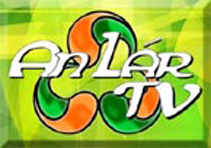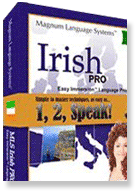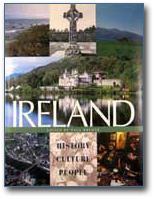Ancient Irish Writing
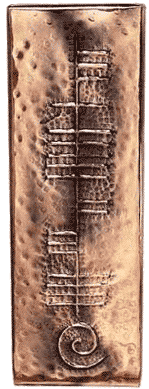 |
The ancient Irish writing known as Ogham is believed to be the earliest recorded script used in Celtic Ireland. The ancient Irish lived in a stable tribal society with learned men who preserved their history by means of this unusual written form of Gaelic. With references to books of the old testament, some of Ireland's early history is compared to biblical history. Some suggest that Ireland was first settled by the daughter of a Greek, hEiru (Erin), who is said to have given the country her name. It is also said that Ireland was inhabited prior to the time of Noah and the flood. Of course, this civilization would have been wiped out during the deluge.
There are references to Noah's son, Japheth, who came upon Ireland after the flood while exploring the seas for new land. The Japhethitic Magogians, named after Noah's son, Japheth, and grandson, Magog, are said to have been one of the earliest tribes to settle in Ireland. This tribe was also known as the Scythians. Their king, Phenius, took it upon himself to study letters and learned all seventy-two languages known at the time. He is credited with founding a college of languages and inventing Ogham. He also appointed Gadel to regulate the Irish language into five dialects known as Gaoidhealg, or Gaelic.
While researching this information, I came upon dates about which I had previously known very little. They were referred to as the 'seven ages of man', beginning with year one, after the appearance of Adam. The date mentioned was 'the year of the world 2317', when the Scythians arrived in Ireland. I do not know how to convert that into modern chronology known as B.C. or Before Christ. Ogham script was used to record the earliest old Irish texts written in about the same era. Ogham inscriptions are found only in the Celtic countries of Ireland, Scotland, and Wales. Most are genealogical inscriptions on corners of large stone slabs.
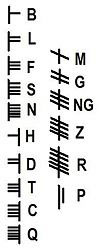 |
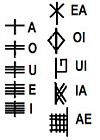 |
|
Ogham Consonants |
Ogham Vowels |
|
Ogham letters are divided into four groups, each containing five letters, for a total of twenty Ogham letters. The Ogham alphabet consists of a series of vertical lines, with horizontal lines crossing it to represent vowels. Sometimes the vowels use dots rather than intersecting lines. When inscribed on stones, Ogham is written vertically from bottom to top. Various opinions exist on the exact origin of the script. Some say that it stemmed from a cryptic way of writing runes (a pagan alphabet of characters), and others claim that it was inspired from the Roman alphabet. Still others believe that it was an original invention.
The order in which the letters appear is a mystery because it is nothing like either the Roman or runic order of letters. The script seems to have some phonetic basis using the names of trees as the sound for each letter; and Ogham is sometimes known as the Celtic Tree Alphabet.
Many years later, old Irish was written with an Irish stylized version of the Roman alphabet, and Ogham disappeared. Some knowledge of Ogham must have been preserved in some form, as its provenance is notated in the fifteenth-century work 'The Book of Ballymote', which also contains other histories of Ireland.
Disclaimer: LittleShamrocks.com is an affiliate website that receives commissions from sales of the products listed. We have purchased and sampled many, but not all, of the products on these pages.
© Copyright LittleShamrocks.com. All Rights Reserved.



